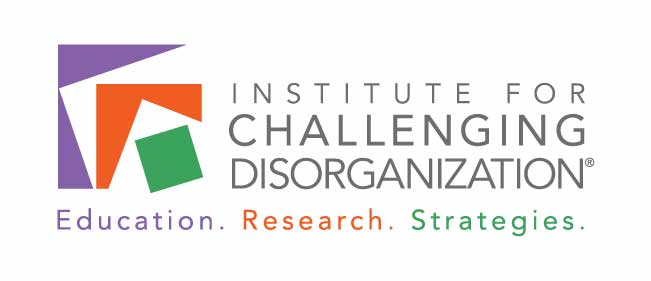- Home
- About Us
- Education and Events
- Certification
- Research
- Resources
- For Subscribers
- Contact us
- International
Research Collaborations
How do emotions and motivations about decluttering A new article by Dr. Catherine A. Roster and Dr. Joseph R. Ferrari published in the Journal of Consumer Affairs examines how people perceive decluttering and how those perceptions affect their motivations and success in completing personal decluttering projects. The authors offer a number of suggestions for professional organizers and coaches to ease the stress and anxiety that some people experience during the organizing process. They also have suggestions for community services that would benefit people trying to reduce their clutter. Download A Summary Having Less here.
Who and Where? Researching Different Clutter Experiences by Helena Lucia Swanson and Devki A. Patel, Recipients of the 2022 ICD Student Research Grants Graduate Students in the Department of Psychology at DePaul University, A summary of research presented at the 2022 ICD Conference held in Chicago, Illinois
Clutter is a problem that plagues almost everyone. With clutter being such a widespread experience, it is crucial to understand why people keep their items and how keeping objects impacts people negatively. Throughout this paper, we report the results of seven (7) research projects providing a deeper understanding of people’s experiences with clutter. More specifically, we dive into
In addition to highlighting people’s experiences with clutter supported by research findings, we detail how these results may be incorporated into interventions by organizing and productivity professionals. Download a copy of the entire White Paper: Who and Where?
“The Impact of Hoarding Cleanouts.” The Hoarding Project (THP), a 501(c)(3) non-profit organization aimed at providing education, research, and treatment for people who hoard, their families, and communities. “Hoarding and the Family” In collaboration with Jennifer Sampson, M.S., LMFT, then a doctoral candidate in the Department of Family Social Science at the University of Minnesota – Twin Cities. Psychological Perception of Home: *This is one of the two studies which includes the Clutter Quality of Life (CQLS) scale, developed by Dr. Roster, in collaboration with ICD.* Catherine Roster, Ph.D., Associate Professor at University of New Mexico and Dr. Joseph Ferrari, Distinguished Professor at DePaul University. Purpose: to learn how clutter impacts a person’s psychological sense of “home.” “The Secret Lives of Objects” In collaboration with Corinne Botz, a Brooklyn-based artist, professional photographer, and author of the book The Nutshell Studies of Unexplained Death (Monacelli Press, 2004). This project considered how objects are connected with our memories, our sense of self, and the process of letting go of possessions. The ultimate goal of this project was to shed light on the relationship people have with objects, as well as the act of anonymously gifting sentimental objects to strangers. Factors leading to Compulsive Hoarding in Adulthood and across the Life Span: Capella University graduate student, Tracey M. Biagas. Fathers of Children with ADHD: Abigail Mintz, MS, who at the time was a doctoral student at the University of Maryland, College Park. This study was designed to learn more about the experiences of fathers of children (age 5-12) who have ADHD or undiagnosed significant attention/disruptive behavior problems. As little is known about parenting behaviors, especially those of fathers, this study provides knowledge that can improve treatment for families of children with ADHD. Safe Passage Strategies Used by Professional Organizers. Led by Catherine A. Roster, Ph.D., University of New Mexico. This study examined factors and strategies used by professional organizers to help clients let go of possessions. Safe Passage appeared to represent a peaceful state of mind clients realized from successfully navigating the emotional, cognitive, and decision-making challenges associated with letting go of meaningful goods. Survey of Organizing Techniques Used by Professional Organizers with Chronically Disorganized Clients. Led by Kit Anderson, former ICD Research Director, examined the frequency of use of the organizing techniques originally proposed for CD clients by Judith Kolberg in What Every Organizer Should Know About Chronic Disorganization. Findings were that “body doubling” was by far the most used technique, followed by avoiding “tactile sympathy.” About half used “maintenance sessions,” “recommending support services,” “treasure hunting,” “sampling/playing favorites,” and “shrines.” Just under half regularly used the “muttering game” and usage of other techniques was much lower. Development of a Chronic Disorganization Inventory Decision Making Among Elderly Clients with Hoarding and Clutter-related Issues "I Think I have a problem with Clutter." University of California, San Francisco (UCSF) and the Mental Health Association of San Francisco (MHASF). |
